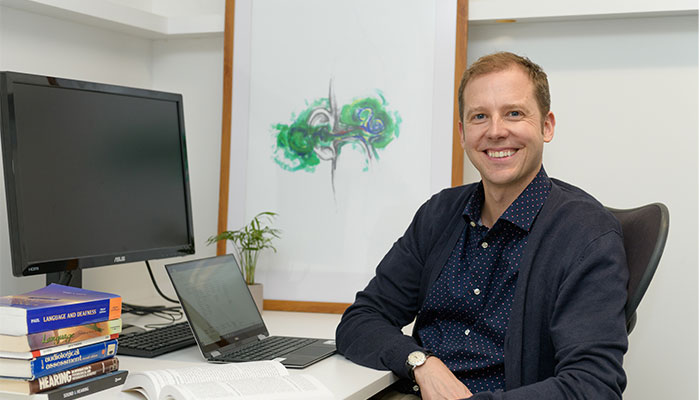It is not uncommon for many people to struggle with hearing problems, with around one in six Australians living with hearing loss.

Hearing aids are very effective in improving communication for people with hearing loss. And yet, according to Associate Professor in Audiology at Macquarie University, Piers Dawes, very few of those people are embracing hearing aid technology.
“Around 20 per cent of people who could benefit from a hearing aid, even actually use a hearing aid,” Dawes says.
“And we have found that a fairly high proportion of hearing aid recipients, about 20 to 40 per cent, don’t use them frequently or even at all.”
"Those who do use hearing aids have typically waited at least 10 years before doing anything about their hearing difficulties."
Shunning hearing aids
According to Dawes, the reasons for this low uptake vary from person to person.
“Perhaps one of the reasons is there is somewhat of a stigma attached to hearing aid use, and it is seen as part of being infirm or getting old,” he says.
Then there is the issue of cost.
People lose their hearing over many decades so it’s harder to notice, and they may blame external factors, such as other people mumbling.
“Hearing aids can easily cost $2000-$3000 per pair or more. And they need to be replaced every couple of years so that is an ongoing cost, not including the cost of batteries as well," he says.
A lack of awareness of hearing difficulties is also a major factor, Dawes says. “People lose their hearing over many decades so it’s harder to notice, and they may blame external factors, such as other people mumbling.”
Barriers to hearing help
In a recent study, Dawes, alongside fellow academics, researched the numbers of people at different stages of getting help for hearing problems.

Many reasons: The high cost and stigma associated with getting old means many people avoid wearing their hearing aids, says Associate Professor in Audiology at Macquarie University, Piers Dawes.
In the study Biopsychosocial classification of hearing health seeking in adults aged over 50 years in England, they looked at those who experience hearing problems, seek help for hearing problems, accept a hearing aid and finally, those who use a hearing aid regularly.
Dawes and colleagues attempted to identify particular barriers along the way to getting help with hearing problems.
They found that the main obstacle was initial recognition of hearing problems. 40% of people with measurable hearing impairment did not report any hearing difficulties.
So it seems that one of the biggest reasons that people with hearing impairment don’t get help is that they don’t perceive that there is a problem.
It is uncertain whether they don’t perceive a problem because they blame external factors for communication difficulties (other people mumbling, for example), because they change their lifestyle so that the hearing impairment doesn’t have so much impact (by avoiding places with high background noise, for example), or because people just accept hearing difficulties as being ‘normal’ for their age.
Why people are anxious about cochlear implants
There are similar trends at work in the world of cochlear ear implants. As Professor of Health Implementation Science and Academic Lead, MD Research at Macquarie University, Frances Rapport, points out, some 5 per cent of adults in Australia who would benefit from cochlear implants actually take up the opportunity.
Manufacturer Cochlear Limited and Rapport’s fellow researchers from the Australian Institute of Health Innovation (AIHI) at Macquarie University set about trying to understand why.

Buddies help: cochlear implant patients talking to people considering the procedure has been shown to allay concerns for those nervous about having the surgery, says Professor Frances Rapport.
Their results, published in the study Barriers and Facilitators to Cochlear Implant Uptake in Australia and the United Kingdom, point to some of the most significant barriers to widespread uptake.
“People were anxious about the idea of cochlear implants because they were worried about surgery and the idea of implanting a foreign body,” Rapport says.
“They were also concerned how they were going to adjust, and what it would look like.”
A lot of those concerns were dispelled when they spoke to someone who had a cochlear implant, so the notion of a “buddying system” is very important, Rapport says.
“People were also worried that their healthcare professional wouldn’t be able to adapt their behaviour to suit the individual needs of the patient,” she says.
People were anxious about the idea of cochlear implants because they were worried about surgery and the idea of implanting a foreign body.
This belief was echoed by the GPs themselves, and even some audiologists, who felt they didn’t have adequate knowledge about cochlear implants or the implantation process, but were keen to receive more training.
Among the recommendations of the study were increasing and improving referral pathways; increased awareness and use of the “buddying system”; and greater education through a focus on online resources, dispelling myths of cochlear implants, and inclusion of cochlear topics in tertiary course for audiologists.
“The good news is the willingness [for change] is there,” Rapport says.
Piers Dawes is Associate Professor in Audiology at Macquarie University He recently spoke about 'Hearing and help-seeking' at Macquarie University’s Australian Hearing Hub.



